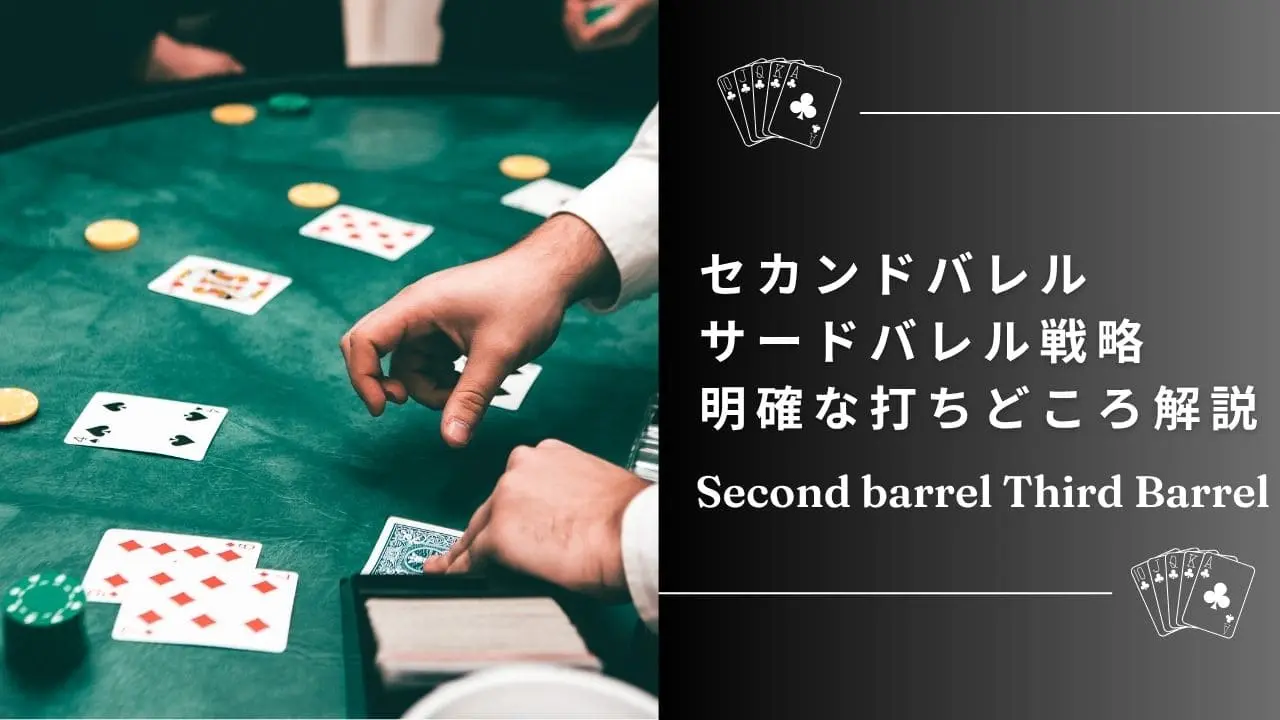Are You Betting Second and Third Barrels Randomly?
Many players can confidently make a continuation bet (CB) on the flop, but when it comes to betting on the turn and river, they often hesitate—should you bet or check? For intermediate players, these streets can significantly influence the outcome of the hand.
The truth is, there are clear situations where you should and should not fire a second barrel (turn bet) or third barrel (river bet). Understanding this strategically and logically, rather than relying on gut feeling, is the first step toward becoming an advanced player.
This article will thoroughly explain when, why, and how to fire the second and third barrels, with practical examples to help you master essential decision-making processes on the turn and river.
What Are Second and Third Barrels in Poker?
In poker, firing a “barrel” refers to betting on subsequent streets after making a flop continuation bet (CB).
- Second Barrel (Turn Bet): The second bet fired on the turn after a flop CB. Used to continue bluffing or to extract more value.
- Third Barrel (River Bet): The third bet fired on the river. While it can secure large pots, incorrect judgment can lead to significant losses.
When the Second Barrel Is Effective
1. When the Board Weakens the Opponent’s Range
On dry boards where an overcard falls on the turn, opponents holding marginal one-pair hands will often feel pressure.
Example:
Flop: ♠9, ♣3, ♦2 → Turn: ♦J
This is a classic spot to pressure opponents into folding weak pairs.
2. When New Drawing Possibilities Emerge
If the turn card adds straight or flush draws, a second barrel can have great expected value as both a semi-bluff and value play.
Example:
Flop: ♦Q, ♠T, ♣4 (CB) → Turn: ♦J
Now you have a gutshot plus a flush draw, providing strong equity and bluff potential.
When the Third Barrel Has Maximum Impact
Bluffing Conditions:
- Opponent’s range is capped.
- Your range strongly represents nut hands.
- Opponent is tight and unlikely to call river bluffs.
Example:
Board: ♠A, ♣K, ♦7, ♥3, ♣2
Your range can easily include AK, sets, and strong hands, while the opponent is likely capped at Kx or middle pairs. A river bluff here is highly effective.
Value Betting Conditions:
- Opponent is likely to call with second-best hands.
- Draws complete naturally on the river, allowing you to credibly represent strong hands.
Example:
If you read the opponent for holding second-best hands like KQ, a value bet with AQ is the correct move.
Practical Decision Example: Bet or Check?
Situation:
- Position: Button (BTN)
- Flop: ♠J, ♣7, ♦4 (CB 1/2 pot) → Opponent calls
- Turn: ♥K (Second barrel 2/3 pot) → Opponent calls
- River: ♣3
- Your hand: ♠A, ♠T (no made hand)
Decision Flow:
graph TD
A[Does your turn bet credibly represent strong hands?] –>|Yes| B{Is the opponent’s river calling range strong?}
B –>|No| C[Recommended: Fire third barrel with pot or overbet]
B –>|Yes| D[Check recommended; third barrel may not succeed]
A –>|No| E[Third barrel is risky; check is advised]
In this case, the opponent’s range likely includes Jx or weak Kx, while your range credibly represents AK, sets, and strong hands. A polarized bluff with a large river bet has a high chance of success.
Risks of Overbetting or Underbetting
- Overbetting too often:
Your pattern becomes predictable, and even weak players may start catching your bluffs. - Underbetting too often:
Your flop CB loses credibility, increasing the risk of opponents calling down and reversing the situation.
Unbalanced betting frequencies are easily exploited by top players. Maintain a balanced, strategically sound approach.
Second & Third Barrel Success Checklist
- Is the opponent’s range capped?
- Does the board favor your perceived range?
- Is the opponent unlikely to catch river bluffs?
- Is your betting story consistent?
If you can answer “YES” to at least three of these, you should confidently consider second or third barrels.
Conclusion
Second and third barrels are essential tools for intermediate players aiming to reach an advanced level.
Decisions on the turn and river should be based on logic and data, not just feel.
- Second barrels rely on equity or applied pressure.
- Third barrels depend on risk/reward balance.
- Always analyze opponent tendencies and range distributions carefully.
Controlling the turn and river is a key step toward consistent poker success.


